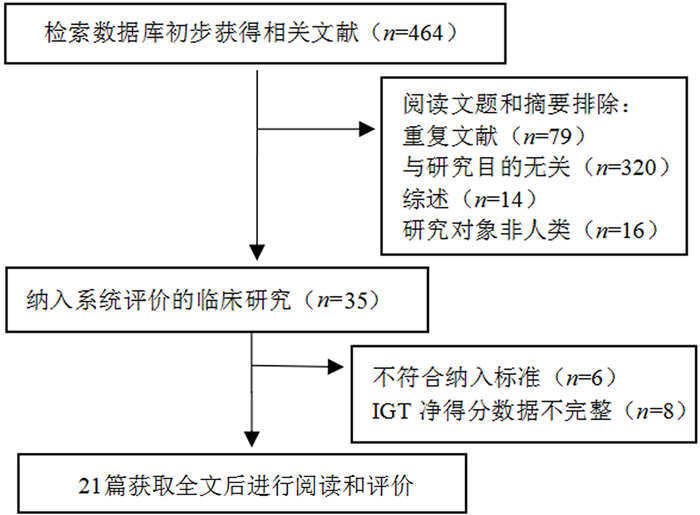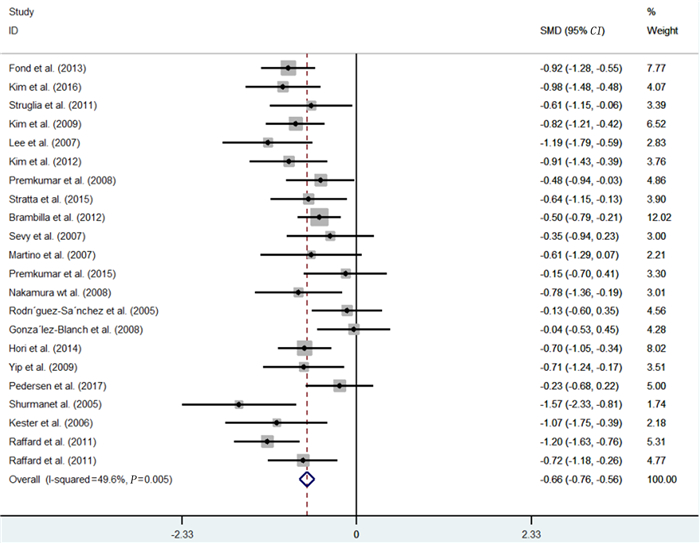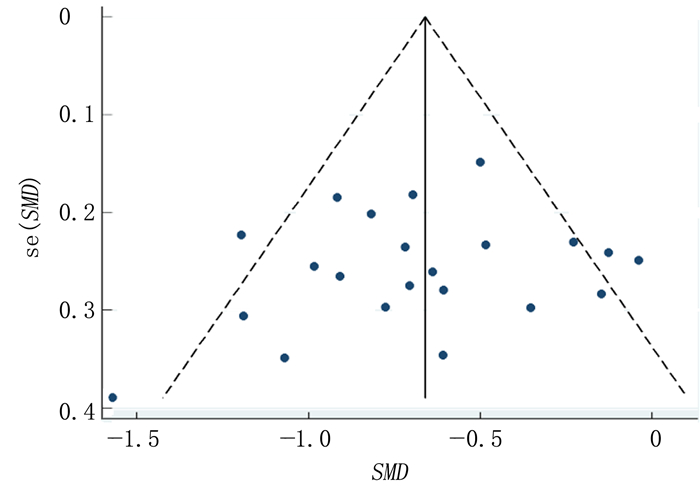精神分裂症是一组病因未明,具有思维、情感、行为等多方面障碍的精神疾病[1]。认知功能障碍在精神分裂症病人中长期存在,严重影响了病人的康复和生活[2]。既往研究认为,精神分裂症病人存在前额叶皮质的异常,异常主要集中在背外侧前额叶皮质上[3]。然而,精神分裂症的脑区异常可能扩展到腹内侧前额叶等其他前额叶皮质。这些脑区的损伤可能与精神分裂症病人的临床表现相关。决策是指从多个备择选项中做出选择的过程[4-5],涉及认知和情绪等功能,其中腹内侧和背外侧前额叶皮质被认为起着关键的作用[6]。爱荷华赌博任务(IGT)是一种广泛用于评估决策的神经心理学测验[7],该测验模仿现实生活中的决策情境,以翻牌的方式呈现,用来测试决策倾向、行为模式以及脑加工模式等。IGT最初应用于测评腹内侧前额叶皮质病变病人的决策特点,结果表明腹内侧前额叶皮质损伤可能导致IGT表现受损[7]。之前针对精神分裂症病人决策方面的研究结果存在自相矛盾的现象,有较多的研究表明精神分裂症病人的IGT表现受损[8-22],但也有研究表明精神分裂症病人IGT表现与健康人相比无显著差异[23-28]。因此,本文对IGT测评精神分裂症病人决策加工的特点进行Meta分析,现将结果报告如下。
1 资料与方法 1.1 检索方法计算机检索PubMed、ScienceDirect、Web of Science、Cochrane Library、Springer Link、Elsevier数据库中所有关于IGT测评精神分裂症病人决策特点的随机对照试验,并同时手工检索图书馆馆藏期刊,检索时间为数据库建库至2018年5月。使用的检索词为Schizophrenia和Iowa Gambling Task,检索式为“Schizophrenia” AND “Iowa Gambling Task”。检索文章限定为国内外研究人员发表的临床研究,出版语言为英语,并追溯已获文献的参考文献,数据不全时与原文献作者联系。
1.2 文献纳入和排除标准纳入标准:①研究类型为随机对照试验;②研究对象为符合美国疾病诊断与统计手册(DSM-Ⅳ)诊断标准的精神分裂症病人,年龄、性别不限;③两组被试均进行IGT;④结局指标为IGT净得分(IGT净得分=选择优势牌的数量-选择不利牌的数量)。排除标准:①重复发表的文献、非随机对照试验、综述、回顾性研究及病案报道;②研究对象非人类;③未提供完整数据的文献。
1.3 质量评价由两位研究者根据上述纳入及排除标准独立地检索并筛选文献,对有分歧的研究通过讨论或由第3位研究者评估决定是否纳入。文献的质量评价采用Jadad质量评分表,分别从以下几个方面进行评价:随机分组序列的产生方法(0~2分)、分配隐藏(0~2分)、双盲法(0~2分)、退出与失访(0~1分)。总评分1~3分为低质量,4~7分为高质量。
1.4 数据提取由两位研究者单独对纳入的文献进行数据提取。提取的数据包括:文献的作者、发表年份,精神分裂症组和健康对照组的样本量、年龄、性别比、平均受教育年限、IGT净得分等。
1.5 统计分析应用Stata 14.2软件进行统计分析。采用Q检验对各研究进行异质性检验,P≤0.1且I2>50%则认为存在明显异质性。分析模型选择:①当P>0.1且I2≤50%时,认为各研究是同质的,选择固定效应模型;②当P < 0.1且I2≤50%时,认为研究异质性可以被接受,选择固定效应模型;③当P < 0.1且I2>50%时,认为存在明显异质性,可采用Meta回归和亚组分析寻找异质性的原因,若找不出异质性的原因则选择随机效应模型。Meta分析中连续变量用x±s表示,计算标准化均数差(SMD)及其95%置信区间(CI),以P < 0.05为差异有统计学意义。采用漏斗图和Egger检验评估发表偏倚,当存在明显的发表偏倚时,进行敏感性分析,观察Meta分析的结果是否会发生改变。
2 结果 2.1 文献检索结果及纳入文献特征初检出相关文献464篇,去除重复后获得文献385篇。经阅读文题和(或)摘要剔除明显不符合纳入标准的文献,余下的文献查找并阅读全文剔除不符合纳入标准者,若IGT净得分不能从文献中直接获得则可通过推断(有5组的数据则可推断总的数据)或联系通讯作者获得,若还不能获得IGT净得分则排除此文献。最终纳入文献21篇[8-28]。文献筛选流程见图 1,纳入文献的基本特征见表 1。
 |
| 图 1 文献筛选流程 |
| 表 1 纳入文献的基本特征(x±s) |
|
|
异质性检验显示,各研究间异质性可以被接受(Q=41.69,I2=49.6%,P < 0.01),故采用固定效应模型进行Meta分析。Meta分析结果显示,精神分裂症组IGT净得分低于健康对照组,差异有统计学意义(SMD=-0.672,95%CI=-0.818~-0.526,P < 0.01)。见图 2。
 |
| 图 2 精神分裂症组和健康对照组IGT净得分比较的Meta分析 |
从漏斗图中可以看出,纳入各研究基本呈对称分布,提示不存在发表偏倚(图 3)。Egger检验未显示纳入研究存在显著发表偏倚(P>0.05)。
 |
| 图 3 精神分裂症组和健康对照组IGT净得分比较漏斗图 |
既往有多项研究显示,精神分裂症病人与健康对照组相比IGT净得分较低,表明精神分裂症病人存在决策受损[8-22]。但还有一些研究表明,精神分裂症病人与健康受试者相比在IGT中的表现没有明显差异[23-28]。结果不一致的原因可能为:第一,大多数研究的样本量较小,出现差异性结果可能是由于净得分的差异很大[23];第二,不同研究中健康受试者的表现差异很大[26];第三,受试者的智商和受教育水平可能与IGT任务中的表现相关[23, 26]。
本文研究对纳入的21篇文献进行Meta分析,结果显示,精神分裂症病人的决策受损,表现为在IGT中的表现较差,即精神分裂症病人在任务进行的过程中不能根据之前的选择来调整之后的选择,不能或需要花费很长的时间才能选择有利的选项。相较于低风险而长期有利的选择,精神分裂症病人更倾向于选择高风险而长期不利的选择。本文结果与之前的一些研究结果是一致的[8-22]。
有研究表明,精神分裂症病人存在认知功能障碍和决策受损的原因可能与腹内侧及背外侧前额叶皮质受损密切相关[23]。前额叶是心理理论能力活动的关键脑区[29],针对前额叶受损病人进行的研究表明,情感加工过程与腹内侧前额叶高度相关[30],腹内侧前额叶皮质受损的病人与健康人相比在很多认知能力上是一样的,但是在复杂的人际关系处理、经济投资或者社会适应等方面精神分裂症病人却存在很大的缺陷[31];背外侧前额叶主要参与工作记忆和大部分的认知调节[32],所以背外侧前额叶的活动与认知心理理论能力存在明显的相关性。IGT是在风险不明确情境下的一种决策任务,是一种相应奖励和惩罚模糊的决策任务,涉及风险选择和概率学习两个因素,可以用来探究某些病人的决策特点以及心理特点[33]。IGT最初主要是用来检测腹内侧前额叶损伤病人的决策功能[7],后来广泛应用于成瘾性病人、情绪情感障碍病人以及精神分裂症病人,是较好的检测受试者决策功能的神经心理学测验。本文Meta分析显示,精神分裂症病人在IGT中的净得分较健康对照组显著降低,表明精神分裂症病人存在决策功能障碍,由此推测其腹内侧和背外侧前额叶的功能可能存在损伤[2]。
本研究为精神分裂症病人决策特点的研究提供了一些新的证据。但是本研究存在如下缺点:所纳入的文献均为英文文献,且排除了一些没有IGT净得分数据的文献;纳入研究的样本量较小,且决策功能易于受到阳性、阴性症状及服用药物的影响。将来可克服以上缺点进一步探讨精神分裂症病人的决策特点。
| [1] |
夏旭, 李心雨, 张春, 等. 精神分裂症的研究[J]. 微量元素与健康研究, 2018, 35(2): 95. |
| [2] |
JIRSARAIE R J, SHEFFIELD J M, BARCH D M. Neural correlates of global and specific cognitive deficits in schizophrenia[J]. Schizophrenia Research, 2018, 201(1): 237-242. |
| [3] |
CAVALLARO R, CAVEDINI P, MISTRETTA P, et al. Basal-corticofrontal circuits in schizophrenia and obsessive-compulsive disorder:a controlled, double dissociation study[J]. Biological Psychiatry, 2003, 54(4): 437-443. DOI:10.1016/S0006-3223(02)01814-0 |
| [4] |
PAULUS M P. Decision-making dysfunctions in psychiatry-altered homeostatic processing?[J]. Science (New York, N.Y.), 2007, 318(5850): 602-606. DOI:10.1126/science.1142997 |
| [5] |
KRUSCHWITZ J D, SIMMONS A N, FLAGAN T, et al. Nothing to lose:processing blindness to potential losses drives thrill and adventure seekers[J]. NeuroImage, 2012, 59(3): 2850-2859. DOI:10.1016/j.neuroimage.2011.09.048 |
| [6] |
OUERCHEFANI R, OUERCHEFANI N, ALLAIN P, et al. Contribution of different regions of the prefrontal cortex and lesion laterality to deficit of decision-making on the Iowa Gambling Task[J]. Brain and Cognition, 2017, 111(1): 73-85. |
| [7] |
BECHARA A, DAMASIO A R, DAMASIO H, et al. Insensitivity to future consequences following damage to human prefrontal cortex[J]. Cognition, 1994, 50(1): 7-15. |
| [8] |
FOND G, BAYARD S, CAPDEVIELLE D, et al. A further evaluation of decision-making under risk and under ambiguity in schizophrenia[J]. European Archives of Psychiatry and Cli-nical Neuroscience, 2013, 263(3): 249-257. DOI:10.1007/s00406-012-0330-y |
| [9] |
KIM M S, KANG B N, LIM J Y. Decision-making deficits in patients with chronic schizophrenia:Iowa Gambling Task and Prospect Valence Learning model[J]. Neuropsychiatric Disease and Treatment, 2016, 12(1): 1019-1027. |
| [10] |
STRUGLIA F, STRATTA P, GIANFELICE D, et al. Decision-making impairment in schizophrenia:relationships with positive symptomatology[J]. Neuroscience Letters, 2011, 502(2): 80-83. DOI:10.1016/j.neulet.2011.07.017 |
| [11] |
KESTER H M, SEVY S, YECHIAM E, et al. Decision-ma-king impairments in adolescents with early-onset schizophrenia[J]. Schizophrenia Research, 2006, 85(1/3): 113-123. |
| [12] |
KIM Y T, LEE K U, LEE S J. Deficit in decision-making in chronic, stable schizophrenia:from a reward and punishment perspective[J]. Psychiatry Investigation, 2009, 6(1): 26-33. |
| [13] |
LEE Y, KIM Y, SEO E, et al. Dissociation of emotional decision-making from cognitive decision-making in chronic schizophrenia[J]. Psychiatry Research, 2007, 152(2/3): 113-120. |
| [14] |
KIM Y T, SOHN H, KIM S, et al. Disturbances of motivational balance in chronic schizophrenia during decision-making tasks[J]. Psychiatry and Clinical Neurosciences, 2012, 66(7): 573-581. DOI:10.1111/j.1440-1819.2012.02403.x |
| [15] |
PREMKUMAR P, FANNON D, KUIPERS E A, et al. Emotional decision-making and its dissociable components in schi-zophrenia and schizoaffective disorder:a behavioural and MRI investigation[J]. Neuropsychologia, 2008, 46(7): 2002-2012. DOI:10.1016/j.neuropsychologia.2008.01.022 |
| [16] |
BRAMBILLA P, PERLINI C, BELLANI M, et al. Increased salience of gains versus decreased associative learning differentiate bipolar disorder from schizophrenia during incentive decision making[J]. Psychological Medicine, 2013, 43(3): 571-580. |
| [17] |
RAFFARD S, CAPDEVIELLE D, GELY-NARGEOT M, et al. Insight is not associated with insensitivity to future consequences in schizophrenia[J]. Psychiatry Research, 2011, 187(1/2): 307-309. |
| [18] |
STRATTA P, CELLA M, DI EMIDIO G A, et al. Exploring the association between the iowa gambling task and community functioning in people with schizophrenia[J]. Psychiatria Danubina, 2015, 27(4): 371-377. |
| [19] |
NAKAMURA M, NESTOR P G, LEVITT J J, et al. Orbitofrontal volume deficit in schizophrenia and thought disorder[J]. Brain, 2007, 131(1): 180-195. |
| [20] |
HORI H, YOSHIMURA R, KATSUKI A, et al. Relationships between brain-derived neurotrophic factor, clinical symptoms, and decision-making in chronic schizophrenia:data from the Iowa Gambling Task[J]. Frontiers in Behavioral Neuroscience, 2014, 8(12): 417-418. |
| [21] |
YIP S W, SACCO K A, GEORGE T P, et al. Risk/reward decision-making in schizophrenia:a preliminary examination of the influence of tobacco smoking and relationship to Wisconsin Card Sorting Task performance[J]. Schizophrenia Research, 2009, 110(1/3): 156-164. |
| [22] |
SHURMAN B, HORAN W P, NTUECHTERLEIN K H. Schizophrenia patients demonstrate a distinctive pattern of decision-making impairment on the Iowa Gambling Task[J]. Schizophrenia Research, 2005, 72(2/3): 215-224. |
| [23] |
SEVY S, BURDICK K E, VISWESWARAIAH H A, et al. Iowa gambling task in schizophrenia:a review and new data in patients with schizophrenia and co-occurring cannabis use di-sorders[J]. Schizophrenia Research, 2007, 92(1/3): 74-84. |
| [24] |
MARTINO D J, BUCAY D, BUTMAN J T, et al. Neuropsychological frontal impairments and negative symptoms in schizophrenia[J]. Psychiatry Research, 2007, 152(2/3): 121-128. |
| [25] |
PREMKUMAR P, FANNON D, SAPARA A A, et al. Orbi-tofrontal cortex, emotional decision-making and response to cognitive behavioural therapy for psychosis[J]. Psychiatry Research-Neuroimaging, 2015, 231(3): 298-307. DOI:10.1016/j.pscychresns.2015.01.013 |
| [26] |
RODRÍGUEZ-SÁNCHEZ J M, CRESPO-FACORRO B, IGLESIAS R P, et al. Prefrontal cognitive functions in stabilized first-episode patients with schizophrenia spectrum disorders:a dissociation between dorsolateral and orbitofrontal functioning[J]. Schizophrenia Research, 2005, 77(2): 279-288. |
| [27] |
GONZÁLEZ-BLANCH C, VÁZQUEZ-BARQUERO J L, CARRAL-FERNÁNDEZ L, et al. Preserved orbitofrontal function in first-episode schizophrenia[J]. The Journal of Nervous and Mental Disease, 2008, 196(1): 67-70. DOI:10.1097/NMD.0b013e318160ea17 |
| [28] |
PEDERSEN A, GOEDER R, TOMCZYK S, et al. Risky decision-making under risk in schizophrenia:a deliberate choice[J]. ? Journal of Behavior Therapy and Experimental Psychiatry, 2017, 56(SI): 57-64. |
| [29] |
李丹丹.青少年精神分裂症患者心理理论和决策能力研究[D].合肥: 安徽医科大学, 2015. http://cdmd.cnki.com.cn/Article/CDMD-10366-1015341947.htm
|
| [30] |
MORIGUCHI Y, OHNISHI T, MORI T, et al. Changes of brain activity in the neural substrates for theory of mind during childhood and adolescence[J]. Psychiatry and Clinical Neurosciences, 2007, 61(4): 355-363. DOI:10.1111/j.1440-1819.2007.01687.x |
| [31] |
GLAESCHER J, ADOLPHS R, DAMASIO H, et al. Lesion mapping of cognitive control and value-based decision making in the prefrontal cortex[J]. Proceedings of the National Academy of Sciences of the United States of America, 2012, 109(36): 14681-14686. DOI:10.1073/pnas.1206608109 |
| [32] |
LEPPANEN J M, NIEHAUS D J H, KOEN L, et al. Deficits in facial affect recognition in unaffected siblings of Xhosa schi-zophrenia patients:evidence for a neurocognitive endophenotype[J]. Schizophrenia Research, 2008, 99(1/3): 270-273. |
| [33] |
李秀丽, 李红, 孙昕怡. 简评爱荷华赌博任务[J]. 保健医学研究与实践, 2009, 6(3): 75-78. |
 2019, Vol. 55
2019, Vol. 55

